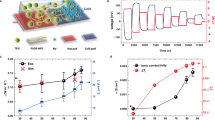Abstract
Macromolecular ionomer solutions exhibiting macroscopic properties that change in response to temperature are referred to as thermally responsive polymer electrolytes (RPEs). Such materials provide a means to control electrochemical systems using an external stimulus that affects the polymer phase behavior and electrolyte properties. RPEs were synthesized with N-isopropylacrylamide, which governs the thermal properties, and varying fractions of acrylic acid, which provides ionic properties. These polymers undergo a thermally activated phase separation in aqueous solutions at a given temperature, thereby altering the ionic strength, pH, and conductivity of the electrolyte solution. In this article, we demonstrate how the molecular properties of RPEs, specifically the ionic composition, influence the temperature-dependent electrolyte properties and the extent to which these electrolytes can control the activity of redox electrodes. Materials with high ionic content provide the highest room temperature ion conductivity and redox activity; however, RPEs with low ionic content provide the highest “on–off” ratio in electrochemical activity at elevated temperatures.
Graphical Abstract







Similar content being viewed by others
References
Stuart MAC, Huck WTS, Genzer J, Müller M, Ober C, Stamm M, Sukhorukov GB, Szleifer I, Tsukruk VV, Urban M (2010) Nat Mater 9:101
Yerushalmi R, Scherz A, van der Boom ME, Kraatz H-B (2005) J Mater Chem 15:4480
Liu F, Urban MW (2010) Prog Polym Sci 35:3
Gil ES, Hudson SM (2004) Prog Polym Sci 29:1173
Motornov M, Roiter Y, Tokarev I, Minko S (2010) Prog Polym Sci 35:174
Nath N, Chilkoti A (2002) Adv Mater 14:1243
Wandera D, Wickramasinghe SR, Husson SM (2010) J Membr Sci 357:6
Ahn S-K, Kasi RM, Kim S-C, Sharma N, Zhou Y (2008) Soft Matter 4:1151
Mather PT (2007) Nat Mater 6:93
Hu J, Liu S (2010) Macromolecules 43:8315
Crespy D, Rossi RM (2007) Polym Int 56:1461
Hu J, Meng H, Li G, Ibekwe SI (2012) Smart Mater Struct 21:053001
Smela E (2003) Adv Mater 15:481
Place ES, George JH, Williams CK, Stevens MM (2009) Chem Soc Rev 38:1139
Alexander C, Shakesheff KM (2006) Adv Mater 18:3321
Yu L, Ding J (2008) Chem Soc Rev 37:1473
Winter M, Brodd RJ (2004) Chem Rev 104:4245
Burke AF (2007) Proc IEEE 95:806
Whittingham MS (2008) MRS Bull 33:411
Arico AS, Bruce P, Scrosati B, Tarascon JM, van Schalkwijk W (2005) Nat Mater 4:366
Simon P, Gogotsi Y (2008) Nat Mater 7:845
Daly E, Saunders BR (2000) Phys Chem Chem Phys 2:3187
Urry DW, Gowda DC, Peng SQ, Parker TM, Harris RD (1992) J Am Chem Soc 114:8716
Huber DL, Manginell RP, Samara MA, Kim BI, Bunker BC (2003) Science 301:352
Hyun J, Lee WK, Nath N, Chilkoti A, Zauscher S (2004) J Am Chem Soc 126:7330
de las Heras Alarcon C, Pennadam S, Alexander C (2005) Chem Soc Rev 34:276
Ta T, Convertine AJ, Reyes CR, Stayton PS, Porter TM (2010) Biomacromolecules 11:1915
Schmaljohann D (2006) Adv Drug Deliv Rev 58:1655
Garbern JC, Hoffman AS, Stayton PS (2010) Biomacromolecules 11:1833
Hong SW, Kim DY, Lee JU, Jo WH (2009) Macromolecules 42:2756
Liang L, Shi M, Viswanathan VV, Peurrung LM, Young JS (2000) J Membr Sci 177:97
Kelly JC, Pepin M, Huber DL, Bunker BC, Roberts ME (2012) Adv Mater 24:886
Liu R, Fraylich M, Saunders B (2009) Colloid Polym Sci 287:627
Zhang Y, Furyk S, Bergbreiter DE, Cremer PS (2005) J Am Chem Soc 127:14505
Salgado-Rodríguez R, Licea-Claveríe A, Arndt KF (2004) Eur Polym J 40:1931
Jones MS (1999) Eur Polym J 35:795
Khan A (2007) J Colloid Interface Sci 313:697
Wallace GG, Spinks GM, Kane-Maguire LAP (2002) Conductive electroactive polymers: intelligent materials systems, 2nd edn. CRC Press, Boca Raton
MacDiarmid AG, Yang LS, Huang WS, Humphrey BD (1987) Synth Met 18:393
Rudzinski WE, Lozano L, Walker M (1990) J Electrochem Soc 137:3132
Acknowledgments
M.E.R. acknowledges partial support from the 3 M Non-Tenured Faculty Grant. A portion of this work was performed at the Center for Integrated Nanotechnologies, a U.S. Department of Energy, Office of Basic Energy Sciences user facility. Sandia National Laboratories is a multi-program laboratory operated by Sandia Corporation, a wholly owned subsidiary of Lockheed Martin Corporation, for the U.S. Department of Energy’s National Nuclear Security Administration under contract DE-AC04-94AL85000. The authors declare no competing financial interest.
Author information
Authors and Affiliations
Corresponding author
Rights and permissions
About this article
Cite this article
Kelly, J.C., Huber, D.L., Price, A.D. et al. Switchable electrolyte properties and redox chemistry in aqueous media based on temperature-responsive polymers. J Appl Electrochem 45, 921–930 (2015). https://doi.org/10.1007/s10800-015-0839-7
Received:
Accepted:
Published:
Issue Date:
DOI: https://doi.org/10.1007/s10800-015-0839-7




